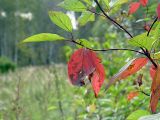
Ветвь. Москва, Кузьминский лесопарк. 21.09.2003.
Маркер на карте не будет указывать точные координаты растения или лишайника.
Маркер укажет лишь на условный центр местности ("географической точки"), где сделано фото.
Открыть картуСмотри также:
Обсуждение (4)
Все фото таксона (328)
Код ссылки на фото
| Создать: | HTML или BBCode с "превьюшкой" |
| Код для ссылки в Сети: | |
| Так это будет выглядеть: |  Swida alba на сайте «Плантариум» |
Ссылки для публикаций
Гуменюк В.И. 2009. Изображение Swida alba (L.) Opiz // Плантариум. Растения и лишайники России и сопредельных стран: открытый онлайн атлас и определитель растений. [Электронный ресурс] URL: https://www.plantarium.ru/page/image/id/9913.html (дата обращения: 28.12.2025).
Гуменюк В.И. 2009. Image of Swida alba (L.) Opiz // Plantarium. Plants and lichens of Russia and neighboring countries: open online galleries and plant identification guide. URL: https://www.plantarium.ru/lang/en/page/image/id/9913.html (accessed on 28 Dec 2025).
Просмотры: 1355Обсуждение
| Наталия Шульц | Swida alba? |
| Виталий Гуменюк | Точно, она. Вспомнил - на кустах были белые ягоды. |
| Наталья Гудкова | С белыми ягодами может быть и Swida sericea, в культуре она распространена очень широко. |
| Сергей Майоров | Cornus sericea is very similar to C. alba. These two taxa are in recent floras most often treated as separate species rather than subspecies, being vicariant in north temperate to subarctic Asia and America, respectively, with no zone of contact. There is some confusion about the differentiating characters. The indumentum on the lower leaf surface is sometimes claimed to differ, but both taxa are fairly densely hairy, with appressed medifixed hairs, sometimes with a few unbranched hairs among them. The shape of leaves differ, although there is much overlap; C. sericea leaves may be considerably larger and are more distinctly acuminate, often tapering into a long apex. The length of the calyx teeth also gives some guidance. The most reliable character, besides the mode of growth, is the shape of the fruit stones (see fig.), easy to observe in herbarium specimens with dried-up fruits. This means, however, that much of the herbarium material is not possible to determine with full certainty. |